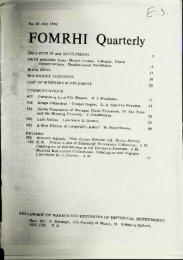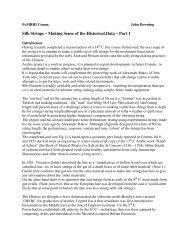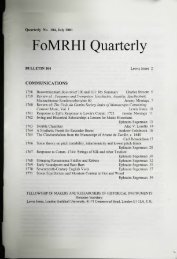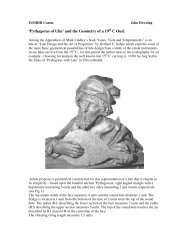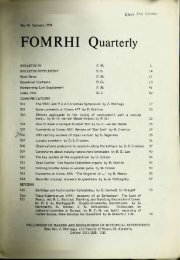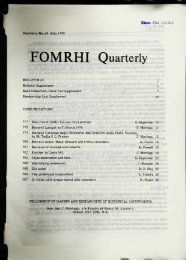•rf - FoMRHI
•rf - FoMRHI
•rf - FoMRHI
Create successful ePaper yourself
Turn your PDF publications into a flip-book with our unique Google optimized e-Paper software.
The amount of information surviving about early music and instruments is strictly<br />
limited. In a very few years, this information on early music-making will be<br />
sufficiently analysed and argued for us to know what they most probably did and<br />
used, to know what they most probably did not do or use, and to delineate what<br />
aspeets of their activities we shall probably never know. We will then be able<br />
to distinguisi 1 between the authentic, unauthentic, and conjectural, and write<br />
authoritative books on early music and instruments. Both authors mention the<br />
realization that their books are far from the last word on the subjects they treat<br />
but this will not prevent many readers from uncritical acceptance of what appears<br />
so attractively in print.<br />
The casual reader will not be seduced into early music by either book. He will<br />
quickly tire of the texts of both. The Munrow book is remarkably thorough and the<br />
detail is too complicated to take in quickly. The Montagu text is simpler but written<br />
in a dryer, less involved style. Relating the text in the latter to the illustrations on<br />
different pages and with different codes is most exhausting. Thus the casual reader<br />
will quickly be reduced to just looking at the pictures of peculiar objects in association<br />
with peculiar names. The new convert will find both books very helpful in<br />
accelerating his learning, but since there are many errors in each, the dangers<br />
mentioned above are most serious. The experienced serious student of early music<br />
already accustomed to both the wild speculation and the ignoring of data contrary to<br />
expectations by the best of scholars will not suffer from these dangers. He will find<br />
each book a mine of valuable information not easily available elsewhere and will<br />
keep copies of both dose at hand.<br />
The books differ greatly in the treatment and choice of illustrations. The Montagu<br />
book restriets itself to early depictions of instruments and photographs of surviving<br />
ones. This is appropriate since the book is about early instruments. In spite of<br />
the text of the Munrow book being mostly about early instruments, the illustrations<br />
are largely about surviving folk relatives of early instruments (country cousins),<br />
modem simulations of early instruments,and the people who contributed their musical<br />
or instrument-making skills to the Early Music Consort of London. His gcnerosity in<br />
plugging the people who contributed to his success and his honesty in pointing out those<br />
non-authentic aspeets of the instruments shown do not detract from what I consider to<br />
be the irresponsibility oi implying that make-believe early instruments played with<br />
obviously modem technique are good enough. I appreciate the altempt in the<br />
illustrations to impart an immediacy of early music being played today, and would be<br />
most happy with the depiction of accurate copies of early instruments played in<br />
positions typical of those shown in early illustrations, but too often this is not the<br />
case. It is true that the majority of the illustrations are appropriately early, but they are<br />
rarely given as much prominence as the modem and folk instruments. The much<br />
welcome exception is the cover. The illustrations in the Montagu book are its<br />
strongest point, being generally very clear. Many are not readily available elsewhere<br />
and those which are are produced with greater quality.<br />
The Munrow text is a remarkably good collection of current beliefs about early instruments<br />
and the bibliography is an excellent guide to the readily available secondary literature.<br />
It also offers a most valuable selection of translations of early sources. I had great<br />
difficulty in finding an originai thought. It is a tremendous Job of research of the type<br />
that Rutherford called "stamp-collecting", with no synthesis.<br />
J





